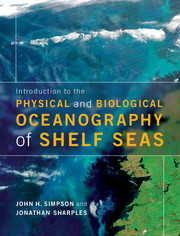Book contents
- Frontmatter
- Contents
- Preface
- Acknowledgements
- Guide to the book and how to make the best use of it
- Symbols
- 1 Introduction to the shelf seas
- 2 Physical forcing of the shelf seas: what drives the motion of ocean?
- 3 Response to forcing: the governing equations and some basic solutions
- 4 Waves, turbulent motions and mixing
- 5 Life in the shelf seas
- 6 Seasonal stratification and the spring bloom
- 7 Interior mixing and phytoplankton survival in stratified environments
- 8 Tidal mixing fronts: their location, dynamics and biological significance
- 9 Regions of freshwater influence (ROFIs)
- 10 The shelf edge system
- 11 Future challenges in shelf seas
- Glossary
- Answers to chapter problems
- References
- Index
- Plate section
- References
2 - Physical forcing of the shelf seas: what drives the motion of ocean?
Published online by Cambridge University Press: 05 June 2012
- Frontmatter
- Contents
- Preface
- Acknowledgements
- Guide to the book and how to make the best use of it
- Symbols
- 1 Introduction to the shelf seas
- 2 Physical forcing of the shelf seas: what drives the motion of ocean?
- 3 Response to forcing: the governing equations and some basic solutions
- 4 Waves, turbulent motions and mixing
- 5 Life in the shelf seas
- 6 Seasonal stratification and the spring bloom
- 7 Interior mixing and phytoplankton survival in stratified environments
- 8 Tidal mixing fronts: their location, dynamics and biological significance
- 9 Regions of freshwater influence (ROFIs)
- 10 The shelf edge system
- 11 Future challenges in shelf seas
- Glossary
- Answers to chapter problems
- References
- Index
- Plate section
- References
Summary
In this chapter we consider the powerful forces that drive the shelf seas, and supply the large amounts of energy which are dissipated within them. We shall see that these forces act mainly through the transfer of properties (momentum, heat, freshwater, etc.) at the sea surface and through the lateral boundary where the shelf seas meet the deep ocean. Together the various forcing mechanisms produce an energetic regime which, in most shelf seas, maintains a high level of energy dissipation far greater than that of the deep ocean. We begin by identifying the principal energy and momentum sources and then consider, in turn, the forcing mechanisms involved and the extent to which the resultant inputs are known and can be related to measurable parameters.
Energy sources
Perhaps the most obvious and striking form of mechanical energy input to the sea arises from surface wind stresses and pressure gradients imposed by the atmosphere. These forces drive ocean currents and generate surface waves whose impact at the coast can be dramatic and is often seen as symbolic of the ocean's power. In many shelf seas, however, energy input through tidal forcing is a more consistent and more powerful source of mechanical energy. Most tidal energy is delivered to the shelf in the form of energy fluxes in tidal waves which originate in the deep ocean, although there is also a (usually small) contribution arising from tidal body forces acting directly on the waters of the shelf seas. Both winds and tides inject very large amounts of kinetic energy to the ocean as a whole; total inputs have been estimated recently as ~1 and ~3.5 TW for wind and tidal inputs respectively (Munk and Wunsch, 1998).
Information
- Type
- Chapter
- Information
- Publisher: Cambridge University PressPrint publication year: 2012
